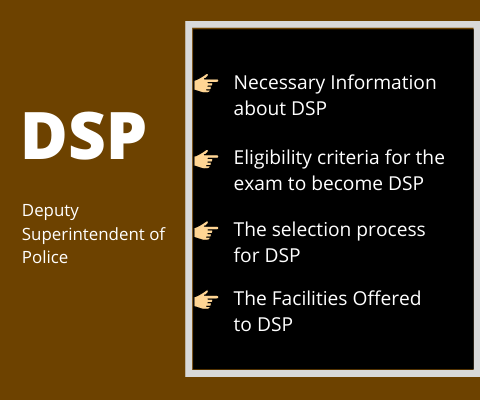Full Form of DSP

DSP Full form is Deputy Superintendent of Police.
DSP is a rank of police officer in the police force in India. DSP represents state police forces which are known as state police officers. The badge of rank for a DSP police officer is a national badge on a shoulder strap above one star.
DSP is similar to Assistant Commissioner of Police (ACP); depending on the rules of state government, they are promoted to IPS after a few years of service.
In the commissioner system, the rank of Deputy Superintendent of Police (DSP full form) or Assistant Commissioner of Police (ACP) was created in 1876 as the policy of Indianisation was introduced. Originally the rank was only held by Indians and was similar to Assistant Superintendent (then the position was only held by Europeans).
DSP also has other meanings, such as DSP full form in computer which stands for Digital Signal Processor. However, in the context of law enforcement in India, DSP full form is Deputy Superintendent of Police.
Eligibility criteria for the exam to become DSP
The Applicant who wants to become Deputy Superintendent of Police (DSP full form in police) has to follow the below-given criteria:
- Candidate must be an Indian citizen
- Required qualification: The Applicants must have completed their graduation in any stream from a recognized board/university or educational institute.
- The Applicants must be between the age of 21 to 30 years old. There are 5 years of relaxation in the upper age limit For SC/ST candidates.
- For Men, the minimum chest expected is 84 cm with a minimum chest expansion of 5 cm.
- A minimum height of 168 cm is required for the male candidates and for the female candidate is 155 cm.
The selection process for DSP
The state-level exam conducted by the State Public Service Commission has to be cleared by the Applicants who want to become DSP. The Applicants who clear this DSP exam undergo probationary training before they are posted as DSPs. The steps:
- Preliminary and Main Written Exam
- Physical Efficiency Test (PET)
- Interview and Medical
The Facilities Offered to DSP
The DSP gets various benefits and facilities along with their pay. The various facilities are as follows:
- The electricity bills are paid by the government.
- The government also pays for the telephone connection.
- The official vehicle was provided to DSP with the driver and beacon.
- The government provides the staff quarter or self-residence at no cost or at a nominal rent.
- For domestic help such as gardeners and cook and also security guards.
- High-level arrangements during official visits.
- The government provides a pension to their spouse.
Interesting Facts about DSP
- In 1969, Shankuntala Vashista was the first woman in the Indian police who later became deputy superintendent.
- The National Police Cadet Crops was the rank of deputy superintendent of police is the highest rank attainable by an officer.
- In the British Empire, the Deputy Superintendent of Police (DSP full form in police) is a rank used by several police forces in the Commonwealth and formerly.
- Deputy Superintendent Assam of Police has inducted Indian sprinter Hima Das.
Conclusion
Now you get an understanding of DSP’s full form of police. DSP is the head of the police force of a district and a high-ranking official. It role of a DSP is to check the work and report of his/her juniors and report to senior officials, under SP manages and also controls the people. It needed and make good harmony among the people of the area.
For those looking to understand the full form of DSP and its applications, DSP also stands for Digital Signal Processor, which is a crucial component in the field of computing and electronics.
Whether you’re interested in the role of Deputy Superintendent of Police or the technical aspects of a Digital Signal Processor, understanding these roles and DSP facility can provide valuable insights into their respective fields.
Read Also:
